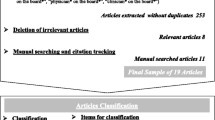Abstract
In a hospital environment that demands a careful balance between commercial and clinical interests, the extent to which physicians are involved in hospital leadership varies greatly. This paper assesses the influence of the extent of this involvement on staff-to-patient ratios. Using data gathered from 604 hospitals across Germany, this study evidences the positive relationship between a full-time medical director (MD) or heavily involved part-time MD and a higher staff-to-patient ratio. The data allows us to control for a range of confounding variables, such as size, rural/urban location, ownership structure, and case-mix. The results contribute to the sparse body of empirical research on the effect of clinical leadership on organizational outcomes.


Similar content being viewed by others
References
American Hospital Association (2012) Chartbook—trends affecting hospitals and health systems. http://www.aha.org/research/reports/tw/chartbook/index.shtml. Accessed May 2012
Blegen M, Vaughn T (1998) A multisite study of nurse staffing and patient occurrences. Nurs Econ 16(4):196–203
Blossom Y, Hsu C, Juan C, Lin C, Lin H, Chen J (2011) The role of leader behaviours in hospital-based emergency departments unit performance and employee work satisfaction. Soc Sci Med 72(2):238–246
Bundesamt für Bauwesen und Raumordnung (2006) Indikatoren, Karten und Graphiken zur Raum- und Stadtentwicklung in Deutschland und in Europa 2006. Selbstverlag des BBR, Bonn
Clement J, Valdmanis V, Bazzoli G, Zhao M, Chukmaitov A (2008) Is more better? An analysis of hospital outcomes and efficiency with a DEA model of output congestion. Health Care Manag Sci 11(1):67–77
Eeckloo K, Herck GV, Hulle CV, Vleugels A (2004) From corporate governance to hospital governance. Authority, transparency and accountability of Belgian non-profit hospitals board and management. Health Policy 68(1):1–15
Eldenburg L, Hermalin B, Weisbach M, Wosinska M (2004) Governance, performance objectives and organizational form: evidence from hospitals. J Corp Financ 10(4):527–548
Fannin J, Barnes J (2007) Recruitment of physicians to rural America: a view through the lens of transaction cost theory. Natl Rural Health Assoc 23(2):141–149
Gerlinger T (2011) Versorgung in ländlichen regionen. Public Health Forum 19(1):1–13
Gilmartin M, D’Aunno T (2007) Leadership research in healthcare—a review and roadmap. Acad Manag Ann 1(1):387–438
Goldstein S, Ward P (2004) Performance effects of physicians involvement in hospital strategic decisions. J Serv Res 6(4):361–372
Goodall A (2011) Physician-leaders and hospital performance: is there an association? Soc Sci Med 73(4):535–539
Hayes L, O’Brien-Pallas L, Duffield C, Shamian J, Buchan J, Hughes F, Laschinger HS, North N, Stone P (2006) Nurse turnover: a literature review. Int J Nurs Stud 43(2):237–263
Klauber J, Robra B, Schellschmidt H (2008) Krankenhausreport 2007: Krankenhausvergütung—Ende der Konvergenzphase. Schattauer Verlag, Stuttgart
Kuntz L, Wittland M (2012) Top management teams in Deutschen Krankenhäusern, working paper. Department of Health Care Management, University of Cologne
Lang T, Hodge M, Olson V, Romano P, Kravitz R (2004) Nurse-patient ratios: a systematic review on the effects of nurse staffing on patient, nurse employee, and hospital outcomes. J Nurs Adm 34(7–8):326–337
Lingard L, Garwood K, Schryer C, Spafford M (2002) A certain art of uncertainty: case presentation and the development of professional identity. Soc Sci Med 59(3):603–616
Molinari C, Alexander J, Morlock L (1995) Does the hospital board need a doctor? The influence of physician board participation on hospital financial performance. Med Care 33(2):170–185
Needleman J, Buerhaus P, Stewart M, Zelevinsky K (2002) Nurse staffing and the quality of care in hospitals. New Engl J Med 346(22):1715–1722
Needleman J, Buerhaus P, Pankratz V, Leibson C, Stevens S, Harris M (2011) Nurse staffing and inpatient hospital mortality. New Engl J Med 364(11):1037–1045
Nugus P, Greenfiled D, Travaglia J, Westrook J, Braithwaite J (2010) How and where clinicians exercise power: interprofessional relations in health care. Soc Sci Med 71(4):898–909
Pointer D (2006) Health care management: organization design and behavior. In: Shortell SM, Kaluzny AD (eds) Leadership: a framework for thinking and acting, 5th edn. Thomson Delmar Learning, Clifton Park, NY, pp 125–147
Porter M, Teisberg EO (2007) How physicians can change the future of health care. J Am Med Assoc 297(10):1103–1111
Pronovost P, Angus D, Dorman T, Robinson K, Dremsizov T, Young T (2002) Physicians staffing patterns and clinical outcomes in critically ill patients. J Am Med Assoc 288(17):2151–2162
Quality Reports (2006/2008) http://www.gba.de/institution/themenschwerpunkte/qualitaetssicherung/qualitaetsbericht/
Schmidt-Rettig B, Eichhorn S (eds) (2007) Krankenhausmanagementlehre—Theorie und Praxis eines integrierten Konzeptes. Kohlhammer Verlag, Stuttgart, chap Führungsstrukturen, pp 217–250
Schultz F (2004) Who should lead a healthcare organization: MDs or MBAs? J Healthc Manag 49(2):103–116
Statistisches Bundesamt (2010) Kostennachweis der Krankenhäuser, Fachserie 12 Reihe 6.3. https://www.destatis.de/DE/Publikationen/Thematisch/Gesundheit/Krankenhaeuser/KostennachweisKrankenhaeuser.html?nn=72108. Accessed May 2012
Succi M, Alexander J (1999) Physician involvement in management and governance: the moderating effects of staff structure and composition. Health Care Manage Rev 24(1):33–44
Sussex J (2003) Public-private partnerships in hospital developments: lessons from the UK’s ‘private finance initiative’. Res Healthc Financ Manag 8(1):59–76
Tiemann O, Schreyögg J (2012) Changes in hospital efficiency after privatization. Health Care Manag Sci. doi:10.1007/s10729-012-9193-z
Trinh H, Begun J (1999) Strategic adaptation of US rural hospitals during an era of limited financial resources: a longitudinal study, 1983–1993. Health Care Manag Sci 2(1):43–52
Weiner B, Shortell S, Alexander J (1997) Promoting clinical involvement in hospital quality improvement efforts: the effects of top management, board, and physician leadership. Health Serv Res 32(4):491–510
Acknowledgements
We would like to thank Christoph Eunicke from Steria Mummert Consulting AG for retrieving the data from xml files, Roman Mennicken for his support in the data management, and Sandra Sülz for typesetting and proof-reading. We also thank colleagues at the Judge Business School for comments and suggestions on prior versions of this paper. We would like to thank three referees for very helpful comments and suggestions which helped us to improve the manuscript.
Author information
Authors and Affiliations
Corresponding author
Rights and permissions
About this article
Cite this article
Kuntz, L., Scholtes, S. Physicians in leadership: the association between medical director involvement and staff-to-patient ratios. Health Care Manag Sci 16, 129–138 (2013). https://doi.org/10.1007/s10729-012-9218-7
Received:
Accepted:
Published:
Issue Date:
DOI: https://doi.org/10.1007/s10729-012-9218-7




